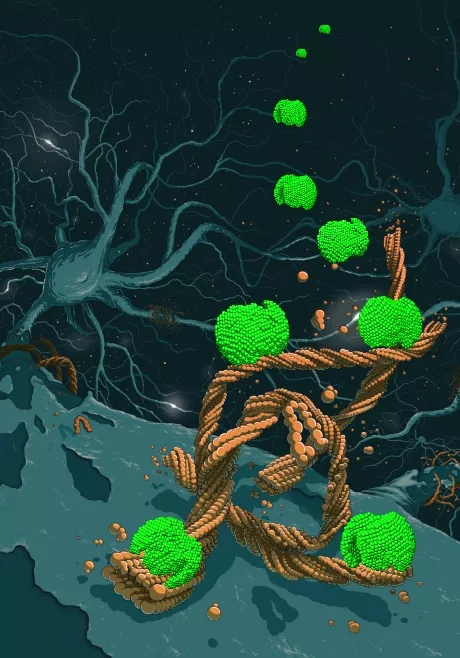PhD project: Nanoparticles against neurodegenerative disease
Nanoparticles in the brain: multitalented drug carriers to target neurodegenerative disease
The aim of the PhD-project is to use cellular biology techniques combined with synchrotron-based spectroscopy to study early changes in brain tissue. The PhD project is part of an interdisciplinary project and the student will work in collaboration with PhD students and researchers from both the Department of Physics and the Medical Faculty at Lund University. The PhD student will study molecular mechanisms of Alzheimer's Disease pathology in the animal model. Other existing tasks within the research group may also be relevant.
Introduction
The Faculty of Medicine is a part of Lund University, and is responsible for education and research within medicine and healthcare. Our academic programs are closely linked with the healthcare system and are firmly anchored in the faculty’s strong research tradition. Our research spans a broad field within experimental preclinical research, near-patient clinical research and health sciences research. The Faculty of Medicine, with its 1,800 employees and 2,700 students in Lund and Malmö, is a knowledge-intensive meeting place for students, teachers and researchers from all over the world.
The Medical Mircospectroscopy (MMS) group is part of the Department of Experimental Medical Science and our research focus is on understanding the role of abnormal protein aggregation in the brain that characterize neurodegenerative disorders. We want to understand why abnormal protein aggregation begins and how these aggregated proteins (α-synuclein, amyloid-β, and tau) may interact in vitro and in vivo combining advanced microscopy with synchrotron based micro- and nano-spectrocopic techniques.
Project specification
Using advanced spectroscopic approaches, our research group has recently found that amyloid protein may aggregate in the neurons at the subcellular level and strikingly, in dendritic spines, which are involved in the memory.
Finding successful therapies for the treatment of neurodegenerative dementias such as Alzheimer's disease (AD) is one of the most challenging tasks existing for human health. One of the strategies to treat dementias is to find a multi-functional carrier that can deliver drugs to protect the synapses and prevent molecular changes related to neurodegenerative dementias. Such drug candidates could be chemically modified dendrimers, nanoparticles with tunable reactive groups located on the surface.
We developed a new AD mouse model which harbor two human genes most relevant for AD: human amyloid-beta and alpha-synuclein tightly linked to AD pathology, and new supersensitive approach to study protein aggregation at the subcellular level (Klementieva et al., 2020 Advanced Science), using these to novel approaches, we believe that the project may help to understand better the AD pathology in humans.Thus, we aim to elucidate the following research questions:
- What happens with synapses when amyloid aggregation begins?
- Which structure of aggregated Abeta and alpha-syn contributes most to early synaptic alterations?
- By which mechanisms nanoparticles (poly(propylene imine) dendrimers with maltose histidine shell) can protect the memory of AD transgenic mice.
Methods
The MMS group has established super-sensitive infrared red an approach that allows studying protein structure directly in tissue and cell at sub-cellular resolution (Klementieva et al., 2020). Thus, with an improved AD mouse model and with novel super-sensitive infrared imaging, we have established protocols to study amyloid protein aggregation at the early stages of AD pathology and the mechanisms on memory protection using the nanoparticles with a chemically tunable shell.
Aims
The first aim of the project will be to study the molecular mechanisms of AD pathology using a newly established AD mouse model. Combining a novel super-resolution infrared imaging approach with cell biology approached, we will aim to answer the questions:
- What happens with synapses when amyloid aggregation begins?
- Which structure of aggregated Abeta and alpha-syn contributes most to early synaptic alterations?
The second aim of the project will be to study mechanisms of memory protection in double transgenic mice, aiming to answer the questions: by which mechanisms nanoparticles with maltose histidine shell can protect the memory of AD transgenic mice. Cloud these nanoparticles be used to neutralize the synaptotoxicity aggregated Abeta and alpha-syn?
Work duties
The student is expected to work with the methods listed above to elucidate the research questions. The main duties of doctoral students are to devote themselves to their research studies which includes participating in research projects and third cycle courses. The work duties can also include teaching and other departmental duties (no more than 20%).
We have a large network of international cooperation partners and the PhD studies might include an exchange with another University or a secondment in in industry.
The doctoral student is expected to work independently, as well as in close collaboration with researchers carrying out other tasks within the project.
Desirable skills
- Excellence in basic cell biology
- Excellence with mouse animal models and animal work (FELASA course)
- Experience with primary culture work
- Excellence in immunohistochemistry
- Excellence in fluorescence imaging
- Excellence in image analysis
- Programming skills
Priority will be given to applicants with documented experience within the project research, in particular within the amyloid aggregation.
The quality of previous writings, such as master's thesis, published reports and other relevant research outputs will be considered.
Enrolment: Medical sciences at the Medical faculty
The Medical Faculty's information pages for doctoral students
Supervisor
Oxana Klementieva, Associate senior lecturer at Medical Microspectroscopy
Oxana Klementieva's contact details
Positions in the 1st call
The call was open from 23 March until 4 May 2020. Of the ten PhD students that were successfully recruited in this call, eight are eligible for GenerationNano funding.
- Smart nanomaterials for green-tech applications
- Characterization of nanostructured magnetic materials
- PhD project on information as fuel
- Photon detection & sustainable energy
- Ultrafast spectroscopy for new solar energy solutions
- Biomarker detection by optical sensing with nanowires
- Morphology and virulence among bacteria
- Multiscale biomechanics from molecules to cells in cancer
- Solubility of amyloid beta peptide (up to two positions)
- Nanoparticles in the brain: multitalented drug carriers to target neurodegenerative disease


